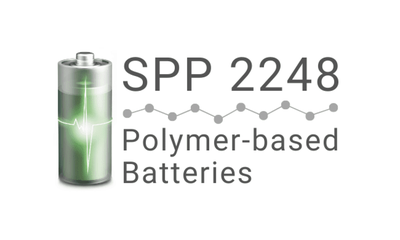
Contact

Prof. Dr. Josef Granwehr
Department Head Spectroscopy
Building 10.3 / Room 417
+49 2461/61-96400
E-MailSPP 2248
Insights into the doping mechanisms of polymer electrolyte/redox-active organic radical polymer lamellar composites
In this project, multilayer polymer batteries are investigated in a holistic approach consisting of synthesis, electrochemical characterization, theoretical and numerical modeling, and a range of EPR techniques. The lamellar cells initially consist of a lithium metal anode, a lithium ion-conducting polymer electrolyte layer, a polymer anion and cation reservoir and an anion-conducting redox-active polymer as a cathode. The properties of the cell design are compared in detail with those of PolyTEMPO, a redox polymer system established for liquid electrolytes.
The synthesis part includes the production and processing of the polymer materials into lamellar composite materials as well as their comprehensive electrochemical characterization. The cathode material is optimized through chemical functionalization specifically with regard to cell voltage, charging and discharging kinetics as well as the anion mobility within the cathode, which is important for charge balancing/charge transfer.
Details of the radical transfer mechanisms and occurring ion species are elucidated using continuous-wave and, if possible, pulsed EPR methods, comparing spectral features of pure and cyclized materials (post-mortem), including elucidation of the distances and distribution of occurring radical species (PELDOR, DEER, ENDOR, HYSCORE). In-operando EPR is performed on selected samples to track the temporal evolution of radical species based on their fingerprint signal and to capture molecular details of charge transfer processes.
Additional insights into mechanistic details of electron and ion transport within the (polymer) layer composite are gained through theoretical and numerical modeling. Quantum chemical methods are used to characterize the electronic properties of the redox-active polymers, while long-range ion transport and any doping mechanisms of organic cathodes are analyzed using molecular dynamics (MD) simulations. MD simulations will also be extended by Monte Carlo steps in order to model electron transfer processes across several monomers and compare them with experimental data. Overall, the systematic approach aims to achieve a fundamental understanding of relevant electrochemical processes, from elementary electron transfer to ion transport through interfaces. These findings serve as a guide for the identification of promising redox-active polymer materials as well as the targeted design of the interfaces within the (polymer) multilayer structures in order to promote the future development of powerful and, if possible, low-solvent or even solvent-free organic radical batteries. This includes the alternative organic electrode materials developed within the group.
